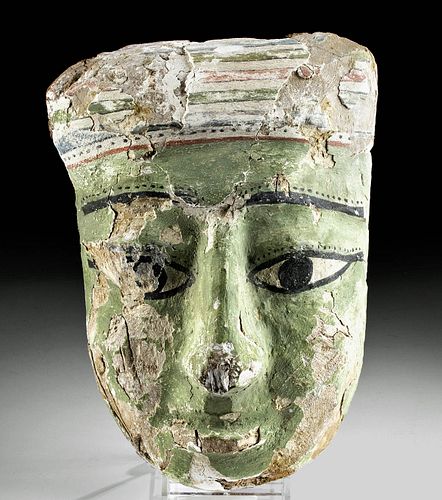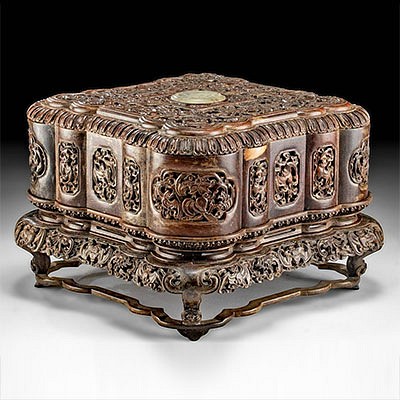Egyptian Painted Gesso / Cedar Sarcophagus Mask
Lot 1
About Seller
Artemis Fine Arts
686 S Taylor Ave, Ste 106
Louisville, CO 80027
United States
Selling antiquities, ancient and ethnographic art online since 1993, Artemis Gallery specializes in Classical Antiquities (Egyptian, Greek, Roman, Near Eastern), Asian, Pre-Columbian, African / Tribal / Oceanographic art. Our extensive inventory includes pottery, stone, metal, wood, glass and textil...Read more
Estimate:
$3,500 - $5,000
Absentee vs Live bid
Two ways to bid:
- Leave a max absentee bid and the platform will bid on your behalf up to your maximum bid during the live auction.
- Bid live during the auction and your bids will be submitted real-time to the auctioneer.
Bid Increments
| Price | Bid Increment |
|---|---|
| $0 | $25 |
| $300 | $50 |
| $1,000 | $100 |
| $2,000 | $250 |
| $5,000 | $500 |
| $10,000 | $1,000 |
| $20,000 | $2,500 |
| $50,000 | $5,000 |
| $100,000 | $10,000 |
| $200,000 | $20,000 |
About Auction
By Artemis Fine Arts
Apr 8, 2021
Set Reminder
2021-04-08 10:00:00
2021-04-08 10:00:00
America/New_York
Bidsquare
Bidsquare : Fine Antiquities | Asian | Ethnographic Art
https://www.bidsquare.com/auctions/artemis-gallery/fine-antiquities-asian-ethnographic-art-6770
Features classical antiquities, ancient and ethnographic art from cultures encompassing the globe. Egyptian, Greek, Roman, Etruscan, Near Eastern, Asian, Pre-Columbian, Native American, African / Tribal, Oceanic, Spanish Colonial, Russian, Fine Art, so much more! All legally acquired, legal to sell. Artemis Fine Arts info@artemisgallery.com
Features classical antiquities, ancient and ethnographic art from cultures encompassing the globe. Egyptian, Greek, Roman, Etruscan, Near Eastern, Asian, Pre-Columbian, Native American, African / Tribal, Oceanic, Spanish Colonial, Russian, Fine Art, so much more! All legally acquired, legal to sell. Artemis Fine Arts info@artemisgallery.com
- Lot Description
Egypt, Late Dynastic to Ptolemaic Period, ca. 664 to 30 BCE. A hand-carved cedar wood mask with large almond-shaped eyes beneath slender brows, a wide nose, rounded cheeks, and full lips, all beneath a rounded headdress that sits low on the forehead. The back of the mask is flat and retains several original dowel holes and dowel fragments. The obverse face is carved with a regal countenance, covered in layers of gesso, and painted with a striking palette of colors. Horizontal red, green, and blue stripes streak across the white headdress, with black outlining the brows and eyes, and white forming the eye sclera. The rarity of this mask stems from the olive-green paint composing the face's base color as green flesh was representative of Osiris - the god of the underworld - once he had been resurrected. The color of this face was perhaps paying homage to Osiris, so the deceased could enter the afterlife with ease. A stunning example of fine Egyptian funerary artistry! Lucite display stand for photography purposes only. Size: 7" W x 9.5" H (17.8 cm x 24.1 cm).
Ancient Egyptians believed it was of the utmost importance to preserve a body of the deceased, because the soul needed a place to reside after the death. Preservation of the body was done via mummification - a process involving the removal of internal organs that were placed in canopic jars, wrapping body in linen, and then embalming. Death masks like this example were created so that the half of the soul that left the body each morning - the "ba" - could recognize its other half that stayed with the body - the "ka" - and return to it every evening. For this reason, death masks were made in the likeness of the deceased. Artisans used different materials. Earlier masks were carved from wood. Later, cartonnage, a material made from papyrus or linen and soaked in plaster which was then applied to a wooden mold, was used. Royal death masks, perhaps the most famous being that of Tutankhamen, were made from precious metals. All death masks were intended to resemble the deceased subject; however, eyes were always slightly enlarged and lips presented in a subtle smile as we see in this example.
Sarcophagus masks like this example were traditionally carved from cedar. Interestingly, cedar wood was not native to Egypt. Egypt did not have verdant forests filled with tall trees, and unfortunately most of its native lumber was of relatively poor quality. So they relied on importing to acquire hardwoods - ebony imported from Africa, cedar and pine from Lebanon. One fabulous obelisk inscription by Thutmose III attests to the luxury of treasured hardwoods. It reads as follows, "They brought to me the choicest products . . . consisting of cedar, juniper and of meru wood . . . all the good sweet woods of God's Land." (Obelisk inscription by Thutmose III - J. H. Breasted, Ancient Records of Egypt, Part Two, p. 321)
Another example of a green-painted sarcophagus mask, of a larger size and with a false beard, hammered for GBP 10,000 ($12,137.75) at Christie's, London, South Kensington "Antiquities" auction (sale 8776, May 2, 2013, lot 71): https://www.christies.com/lotfinder/ancient-art-antiquities/an-egyptian-gesso-painted-wood-sarcophagus-mask-late-5673330-details.aspx?from=searchresults&intObjectID=5673330&sid=0d06c0a6-4caf-4f12-9199-34af4d9a344e
Provenance: ex-private Pennsylvania, USA collection; ex-William Ashby estate collection, California, USA before 2010
All items legal to buy/sell under U.S. Statute covering cultural patrimony Code 2600, CHAPTER 14, and are guaranteed to be as described or your money back.
A Certificate of Authenticity will accompany all winning bids.
We ship worldwide and handle all shipping in-house for your convenience.
#148902Losses to areas of chin, forehead, peripheries, and verso as shown. Chipping to nose, lips, verso, and several areas of painted gesso, with fading to original pigmentation, several stable fissures, and light encrustations. Great traces of original gesso and paint color throughout. Old resin material on several areas of verso. Mounted with modern metal ring loop on verso for display purposes.Condition
- Shipping Info
-
All shipping is handled in-house for your convenience. Your invoice from Artemis Gallery will include shipping calculation instructions. If in doubt, please inquire BEFORE bidding for estimated shipping costs for individual items.
-
- Buyer's Premium



 EUR
EUR CAD
CAD AUD
AUD GBP
GBP MXN
MXN HKD
HKD CNY
CNY MYR
MYR SEK
SEK SGD
SGD CHF
CHF THB
THB














